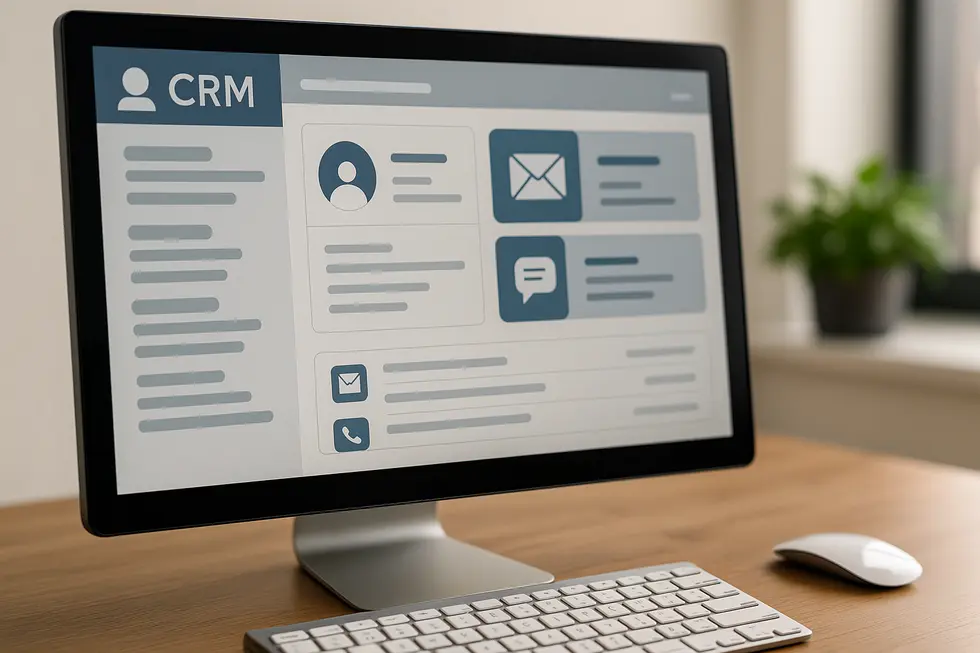Automating the Chaos of Managing Newsletters and Campaigns Manually: Tools and Technologies

1. Harnessing Advanced Technologies to Simplify and Scale Newsletter and Campaign Automation
Technological progress has revolutionized the way marketers handle newsletters and campaigns by enabling sophisticated automation across multiple touchpoints. Modern platforms integrate intuitive drag-and-drop editors, AI-powered content repurposing, and dynamic audience segmentation to tailor messages precisely and promptly. Combining email automation with CRM workflow integrations, marketers can streamline lead nurturing and campaign sequencing without manual oversight. Additionally, real-time analytics provide actionable insights to optimize performance continuously. By merging these innovations, teams reduce operational complexity, ensure consistent multi-channel messaging, and enhance customer engagement — transforming chaotic manual processes into seamless, scalable marketing systems. For a deeper dive into streamlining communications, explore how to unify communication across email, chat, and social channels. More info: https://bigredjelly.com/services/grow/marketing-flywheel/email-marketing-automation/
2. Unlocking Economic Efficiency: How Automation Drives Cost Savings and Revenue Growth in Newsletter Management
Automating newsletter and campaign management yields significant economic benefits by drastically cutting time and costs associated with repetitive tasks. This efficiency often reduces operational expenses by up to 75%, allowing businesses to operate leaner while maintaining higher quality. Personalized, behavior-triggered emails generate substantially greater revenue—up to 320% more—by engaging customers with timely, relevant content that fosters loyalty. Moreover, automation scales effortlessly with growing audiences, avoiding proportional staff increases. Customer experience improves with faster responses and consistent messaging, boosting retention. Freed from manual duties, marketing teams pivot to strategic initiatives, enhancing creativity and reducing burnout. Explore how these transformative benefits reshape costs and growth in the streamlined business environment and beyond. For more insights, visit gorevity.com.
3. Navigating Geopolitical Risks in Automating Newsletter and Campaign Management
Automating newsletters and campaigns introduces complex geopolitical challenges, especially as businesses depend heavily on global cloud providers. Digital sovereignty concerns arise when political tensions threaten access to critical platforms, risking communication halts. Cybersecurity risks escalate with potential state-sponsored attacks targeting automated systems, risking operational disruption and reputational damage. Additionally, geopolitical instability influences market behavior, requiring automation tools to adapt swiftly. The ethical use of AI-driven features further underscores the need for responsible automation amid global tensions. Integrating real-time geopolitical risk analytics and flexible multichannel automation enhances resilience, helping businesses maintain uninterrupted, secure marketing communication. Explore how robust strategies can safeguard automation against international uncertainties at Seerist.
4. How Automation Transforms Engagement and Efficiency in Newsletter and Campaign Management
Automation reshapes how organizations engage with their audiences by boosting efficiency and personalization. It streamlines repetitive tasks, reducing errors and freeing marketing teams to focus on creative initiatives. Automated segmentation delivers tailored messages, increasing open rates by up to 76% and clicks by 152%, fostering deeper customer connections. Centralized platforms enhance collaboration across departments, unifying communication channels like email, SMS, and social media. Real-time analytics empower data-driven decisions, replacing guesswork with insight. Additionally, automation lowers operational costs and scales seamlessly with business growth. This evolution elevates workplace satisfaction by reducing mundane tasks and enabling strategic focus, heralding a new era in digital marketing. For a comprehensive overview on how email automation boosts engagement, visit this resource.
5. Strategic Automation: Best Practices to Streamline Newsletter and Campaign Management
Effective automation of newsletters and campaigns hinges on selecting integrated platforms that unify CRM, analytics, and communication tools for seamless data flow. Maintaining clean, segmented mailing lists enhances deliverability and enables tailored messaging that aligns with the customer’s journey stages. Deep personalization through dynamic content transforms bulk emails into relevant, humanized interactions. Establishing clear campaign objectives drives cohesive workflows, which must be rigorously tested and continuously optimized based on engagement metrics. Advanced AI-powered features help optimize send times and content, improving response rates. Upholding privacy and regulatory compliance remains vital to sustaining trust. These strategies, combined with automation, convert chaotic manual processes into efficient marketing engines. For further insights, explore unifying communication across channels and consult comprehensive automation guides to master this transformation.
Streamlining Customer Communication by Integrating CRM with Multichannel Management

1. Unifying Customer Data to Enhance Manual Newsletter and Campaign Operations
Centralizing customer data through an integrated CRM and multichannel system transforms manual newsletter and campaign management. By consolidating personal details, interaction history, and purchase behaviors into one reliable database, marketers gain a 360° customer view for precise segmentation and personalized outreach. This integration supports manual control of campaigns while leveraging automation features like dynamic content insertion based on unified data. Incorporating omnichannel messaging—including email, social media, and calls—ensures consistent communication flow and seamless two-way synchronization. Such centralization reduces redundancies, strengthens compliance, and enables smarter marketing decisions, ultimately delivering a cohesive customer experience. Discover more about unifying communication channels effectively.
For deeper understanding of how customer master data management enhances CRM capabilities, visit https://www.stibosystems.com/blog/crm-and-customer-master-data-management
2. Crafting Seamless Customer Journeys with CRM-Enabled Multichannel Campaigns for Heightened Engagement
Designing effective customer journeys in manual newsletter and campaign management demands a strategic fusion of visual mapping, CRM integration, and multichannel synchronization. Begin by plotting detailed journey maps that track user interactions across emails, SMS, and social platforms, highlighting key touchpoints and potential friction areas. Integrating these channels into a centralized CRM ensures all communications maintain context, allowing for informed, personalized interactions. Leveraging AI insights within the CRM uncovers engagement patterns and predicts drop-offs, enabling manual adjustments to campaign timing and content relevance. This approach combines human control with data precision, creating tailored experiences delivered consistently across channels, maximizing customer connection and campaign impact. For deeper guidance on unifying communication channels within CRM, explore this comprehensive resource on omnichannel CRM integration. For detailed methodology on omnichannel journey design, see the Kustomer Omnichannel Guide.
3. Harmonizing Manual Campaign Crafting with Automation Through Integrated CRM and Multichannel Strategies
Balancing the manual execution of campaigns with automation requires a seamless fusion of human creativity and intelligent systems. Integrating CRM with multichannel platforms ensures customer data flows uninterrupted across emails, SMS, and social media, enabling tailored, timely interactions. Automation handles routine, data-driven targeting and scheduling, while marketers retain control for nuanced messaging and innovation. This hybrid model optimizes efficiency without sacrificing brand voice, fostering continuous testing alongside data-driven refinement. Embracing such strategies delivers engaging, personalized customer journeys, blending technology with strategic oversight. For more on effective CRM automation, see this practical resource on automating CRM data updates. For enterprise implementation guidance, consult this detailed marketing automation resource.
4. Unifying Multichannel Attribution and Analytics for Smarter CRM-Driven Campaigns
Successfully managing newsletters and campaigns manually demands a strategic grasp of multichannel attribution combined with CRM integration. Attribution models illuminate how each communication channel—email, SMS, or social media—contributes to conversions within defined windows, allowing marketers to credit touchpoints accurately. This understanding enables precise coordination of messaging and timing across channels, delivering a consistent, personalized experience. Although manual efforts lack full automation, leveraging analytics integrated into CRM platforms empowers marketers to track customer journeys and engagement metrics precisely, paving the way for data-driven optimizations. Such a unified approach minimizes guesswork, creating a coherent brand narrative that maximizes campaign impact despite operational constraints. For insights on integrating CRM data with automated workflows, see this guide on how to automate CRM data updates. For a deeper understanding of cooperative multichannel attribution, visit Klaviyo Cooperative Multi-channel Attribution.
5. Choosing the Right CRM and Multichannel Features to Streamline Manual Campaign Management
Selecting the proper CRM with deep marketing integration is key for managing newsletters and campaigns manually yet efficiently. Look for platforms that unify lead data across email, social media, and sales pipelines, enabling precise segmentation and behavior-triggered emails. Robust contact management with custom fields and tags empowers tailored outreach, while conditional workflows ensure complex but controlled automation. True multichannel support consolidates interactions from various platforms into a single dashboard, allowing manual oversight without losing responsiveness. Workflow automation should enhance efficiency but permit content customization and timing adjustments to maintain personal touches. Balancing these features in one system turns chaotic manual handling into a streamlined process aligned with strategic goals. Learn more about unifying communication across channels to optimize your approach. For deeper insights, explore external resources on effective CRM integration at NetSuite CRM Integration.
Leveraging AI and Workflow Automation to Streamline Managing Newsletters and Campaigns Manually

1. Automating Content Discovery and Creation to Simplify Newsletter Management
Automating newsletter content sourcing and creation fundamentally transforms the manual chaos into a streamlined process. AI can continuously scan multiple sources, filtering new relevant content based on quality parameters to ensure newsletter consistency. Once sourced, AI-driven summarization tools generate clear, engaging drafts that reduce hours spent on writing. These drafts can be collaboratively refined within workflow platforms, maintaining voice and coherence. Automation then schedules campaigns by analyzing audience behavior, personalizing delivery at scale to maximize engagement. Integrated real-time performance tracking allows marketers to focus on strategy instead of manual execution. This holistic automation approach saves time, minimizes errors, and elevates content quality, turning newsletters into dynamic customer touchpoints. For further insights on integrating automation with CRM, see automate CRM data updates. A detailed case study exemplifies these benefits at scale: https://powerplatformer.com/how-i-fixed-our-20000-subscriber-newsletter-problem-with-one-brilliant-ai-workflow/
2. Enhancing Email Marketing Efficiency and Personalization Through AI-Driven Workflow Automation
Artificial intelligence transforms email marketing by automating data collection, list management, and campaign execution to reduce manual effort drastically. By analyzing user behavior, AI personalizes messages at scale, tailoring content to maximize engagement without extra workload. Automated workflows trigger emails based on actions and optimize send times dynamically, continuously improving results with minimal intervention. This integration shortens production cycles and unifies segmentation, content creation, and performance tracking, freeing marketers to focus on strategy. For solo entrepreneurs or teams alike, adopting AI-powered automation unlocks highly efficient, personalized communication, driving growth seamlessly. For more on streamlining communication tools, see unifying communication across channels.
External insights on AI email marketing effectiveness can be found at HubSpot’s detailed guide: https://blog.hubspot.com/marketing/ai-email-marketing
3. Transforming Marketing Operations with AI-Powered Workflow Automation and Data-Driven Lead Prioritization
Integrating AI-driven analytics and lead scoring into marketing workflows revolutionizes how newsletters and campaigns are managed. By automating content creation, personalized email triggers, and real-time performance analysis, marketing teams save significant time while improving message relevance and quality. Intelligence embedded within CRM integrations enables automatic lead segmentation and prioritization based on engagement signals, allowing marketers to focus outreach effectively. Such predictive analytics reduce guesswork and facilitate continuous optimization, elevating conversion rates. Furthermore, seamless collaboration tools and end-to-end workflow orchestration unify campaign processes, reducing manual tasks without sacrificing strategic creativity. For marketers seeking to deepen operational efficiency, exploring how AI streamlines complex tasks can be transformational. Learn more about optimizing lead qualification strategies here.
For an in-depth case study on intelligent workflow integration, see this detailed resource: https://powerplatformer.com/how-i-fixed-our-20000-subscriber-newsletter-problem-with-one-brilliant-ai-workflow/
4. Integrating AI-Driven Tools and Scalable Automation Workflows to Transform Newsletter and Campaign Operations
Integrating AI-driven tools with workflow automation enables scalable, efficient newsletter and campaign management. Automated content curation reduces manual vetting by generating summaries from curated sources. AI enhances personalization by predicting customer behavior, optimizing send times, and tailoring messages dynamically. Collaboration platforms streamline drafting and approval, maintaining brand voice without sacrificing speed. No-code automation solutions empower teams to deploy targeted email sequences rapidly without coding expertise. Continuous monitoring and data integration across marketing stacks ensure campaigns improve through real-time insights. This holistic setup transforms chaotic manual processes into streamlined systems, saving time and boosting engagement. Explore detailed strategies in this smart CRM automation guide. External resource: How I fixed our 20,000 subscriber newsletter problem with one brilliant AI workflow.
5. Unveiling the Wider Impacts of AI-Driven Campaign Automation on Economy, Society, and Geopolitics
AI-driven automation transforms newsletter and campaign management by cutting labor costs and enhancing engagement through personalized content and precise timing. Economically, this enables businesses to grow without proportionally increasing staff, yet brings job displacement risks. Societally, while customer experience improves, centralization of AI control in few hands threatens diversity and democratic integrity. Geopolitically, AI automation aids rapid information dissemination and supply resilience but risks manipulation through propaganda and consolidated tech power. Addressing these challenges demands responsible governance to balance innovation benefits with ethical and societal safeguards. Discover more on streamlining operations in scaling systems not headcount. For expanded insights, see AI Now Institute’s 2025 report on societal challenges posed by concentrated tech power.
Final thoughts
By embracing automation tools, integrating CRM features, and employing AI-driven strategies, small and medium businesses can effectively manage their newsletters and campaigns, ensuring improved efficiency and engagement in a competitive market.
Want to design your own AI-powered process? Start building with Level 1: Kick-Start – no tech skills needed.
About us
vaiaverse is the home of next-generation AI agents – digital employees that handle real business tasks across lead generation, sales, and customer support. Whether it’s qualifying leads by phone, answering common questions over WhatsApp, or managing follow-ups by email, our ready-made and bespoke AI Agents are built to save time, cut costs, and scale your operations without hiring. From simple drag-and-drop onboarding to advanced AI teams with SLAs – vaiaverse offers flexible solutions for companies ready to automate what slows them down and double down on what drives growth.









